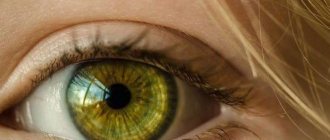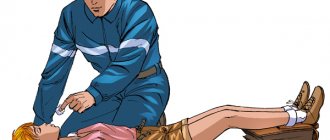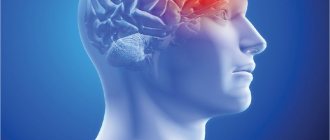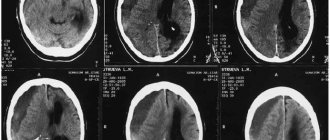Sometimes states arise when clear consciousness, due to the action of certain factors, becomes clouded and narrowed. In such a twilight state of consciousness, a person can commit socially dangerous actions and cause irreparable harm to objects and people. This disorder of consciousness is difficult because it arises and disappears suddenly, without any prerequisites or consequences for the person himself.
Twilight stupefaction - what is it and how does it manifest?
A twilight state of consciousness is a mental state with deep disorientation, limitation of consciousness on certain objects or persons, accompanied by psychomotor restlessness and aggression.
An episode of twilight disorder of consciousness is subsequently replaced by complete amnesia; the person cannot remember how he behaved, what happened around him during the narrowing of consciousness.
In clinical practice, there are often cases when a person unknowingly leaves for another city or region. He subsequently describes his state as follows: “Sitting on the bus, I seemed to think or close my eyes for a few seconds... I didn’t understand how I ended up in a place unfamiliar to me. I asked a passerby, it turned out I was in another city...” However, not in all cases this violation is harmless; a person can unknowingly seriously injure or kill, and with frantic cruelty.
Twilight disorder of consciousness refers to disorders of higher mental processes. With the help of consciousness, a person learns about the world around him, himself, and adapts to changing environmental conditions.
Being in a clear consciousness, a person easily relates himself and the surrounding reality, soberly assesses his capabilities. In this case, they say that he is correctly oriented in location, time, surrounding situation and his own personality.
Guess the riddle:
Two young sisters went out to worship the sun, and under the golden sun they became embarrassed, blushed, and put on scarlet dresses. Show answer>>
Two new maple Soles, two meters high: You put two feet on them - And run through the big snow. Show answer>>
Two legs on three legs, and the fourth in the teeth. Suddenly four came running and ran away with one. Two legs jumped up, three legs picked up, and three by four. But four screamed and ran away with one. Show answer>>
Main features
4 main signs of impaired consciousness:
- detachment from reality: a person does not understand what is happening around him, attention is narrowed to one or several objects, he is not interested in people and external circumstances,
- allo- and autopsychic disorientation of varying degrees of severity: impaired perception of place, time, one’s personality,
- thinking disorder: a person is unable to clearly express his thoughts and answer questions asked, speech is confused, incoherent,
- memory impairment: after the state is normalized, a fragment during which consciousness was narrowed falls out of memory.
Twilight disorder of consciousness is associated not only with disorientation, but also with various automatisms - stereotypical, sharp, repetitive movements, sometimes even of a professional nature: during a twilight disorder, a carpenter makes movements as if working on a machine, an operator continues to work on an assembly line, and a bus conductor – sell tickets to imaginary passengers.
As a rule, most often a person is in motor agitation, moves chaotically, movements are not purposeful and destructive in nature.
There are several types of mental automatisms: trance and fugue. During trance, ambulatory automatisms have a complex structure; movements from the outside seem quite consistent. However, these actions were not planned by the person himself; they are ineffective.
Most often, patients with this variant of twilight narrowing of consciousness are prone to moving, traveling in transport, and unknowingly leaving for another city or region. Outwardly, one notices a drowsy appearance and a certain confused detachment from what is happening. The trance can last from several minutes to several days.
A fugue is a sudden change of state with the need to escape or run. Movements are also aimless and unrelated to the environment. The fugue is short-lived, only a few minutes.
A narrowing of consciousness occurs suddenly against the background of emotional stress, anger, rage, fear. Both hallucinatory and illusory experiences at the height of affect are characteristic.
Twilight disorder can occur not only during the day. Disturbances that occur at night are called somnambulism or sleepwalking.
Delirium
Delirious stupefaction is characterized by the presence of predominantly psychoproductive symptoms. These include abundant hallucinatory and illusory disorders and the acute sensory delirium determined by them. In this case, true visual hallucinations predominate, although tactile and auditory deceptions of perception are also possible. Their content is usually unpleasant for the patient and is threatening in nature. These can be monsters, beasts of prey, skeletons, small animals and insects, small humanoid creatures. Hallucinations quickly replace each other; wave-like influxes of visions are characteristic.
Behavior is subordinated to emotions, patients are usually restless motorly up to the development of psychomotor agitation. Aggression is directed at hallucinatory images and can affect others. Affect is variable and determined by the content of hallucinations. Generally, anxiety, anger, and fear predominate, but transient states of curiosity and enthusiasm are possible. Preoccupation with hallucinations leads to complete or partial disorientation, and false orientation in space and time is often noted.
Delirium is a wave-like condition. It is characterized by lucid windows: spontaneous periods of lucidity, when the patient’s perception of the environment and the overall level of brain functioning improve. The condition also worsens in the afternoon with an increase in hallucinatory influxes in the evening and at night. Lucid windows most often occur after awakening; during them, the person is asthenized, partially oriented and moderately critical. In addition, delirium is characterized by stages of development, with each stage being reversible.
At the first stage, there are no hallucinations yet, but there are influxes of vivid memories, increased and uncontrollable associations, and distracted attention. The person is talkative, affectively unstable, not critical enough and is not always clearly oriented. His behavior becomes inconsistent, and his sleep is restless and superficial, with disturbing, overly vivid dreams.
At the second stage, illusions and pareidolia appear, disturbances of attention are aggravated with difficulty in perceiving the environment. The third stage of delirium is characterized by multiple true hallucinations and associated sensory delusions. Even when scene-like visual hallucinations appear, the feeling of their alienness remains. The patient does not become involved in imaginary events, but observes them or opposes himself to them. Behavior is subject to emotions, orientation deteriorates sharply.
The fourth stage is a severe disintegration of thinking with complete immersion in experiences and detachment from the outside world. Delirium at this stage is called muttering. The man shakes something off himself, makes picking movements, fidgets with the bed, and mutters for a long time. Verbal activity is practically independent of external factors; strong sound and painful stimuli lead to a temporary increase in the volume of pronounced sounds and words.
A special form of delirious stupefaction is occupational delirium, in which hallucinatory-delusional disorders are fragmentary in nature and do not determine behavior. Against the background of deep detachment and disintegration of thinking, stereotypically repetitive movements appear, which are associated with the automation of the patient’s professional activity. This could be imitation of working on a machine, sweeping, using abacus, knitting. It is also possible to repeat simple gestures and body movements typical for a given person.
How does a disorder of consciousness occur?
Consciousness is disrupted sharply and suddenly, without any prerequisites. The condition returns to normal just as quickly, leaving no consequences on the person’s well-being.
With the dysphoric version of twilight disorder of consciousness, the patient looks detached from the world around him, his facial expression is angry, anxious. Productive contact with a person in this state is impossible. The behavior does not correspond to what is happening. Criticism is completely lost.
With hallucinatory twilight disturbance of consciousness, bright, imaginative, threatening hallucinations occur. More often, these may be auditory or visual hallucinatory phenomena that cause aggressive or defensive behavior in a person.
Destructive behavior can be directed at objects or even people. Stereotypical actions are carried out with particular force and cruelty, for example, while in a twilight state of consciousness, a person can inflict 30 or more stab wounds.
In delusional twilight disorder, behavior is determined by a delusional interpretation of what is happening. More often, delusions of persecution occur; the patient either takes a defensive position or seeks to escape from imaginary ill-wishers.
Symptoms
Symptoms of clouding of consciousness: unclear thoughts, unintelligible thinking, disorientation in space, confusion, confusion, disordered speech, psychological changes in behavior, amnesia, the ability to reflect and think slows down.
If you have any of the above symptoms, you should urgently contact a neurologist, traumatologist, therapist, psychotherapist or toxicologist. If this disease is left untreated, it can lead to accidents and various crimes, because... the individual is unable to function logically and well in society.
Experts do not advise self-medication. Because all treatment methods have contraindications, it is possible to harm your health even more. It should be borne in mind that the causes of temporary clouding of consciousness are different, therefore the stages of treatment will be different according to the individual approach to the patient. There is an important aspect in practice, which shows numerous cases when clouding dissipates by itself over time and the person returns to normal.
Natalia Lobanova
There are several different forms of impairment of consciousness, and one of these is stupefaction - a transient disturbance of mental activity that can last minutes, hours, days, less often than a week.
This diagnosis is made in the following conditions:
- detachment from the surrounding world, which sometimes reaches the complete inability to perceive reality;
- with partial or complete disorientation in time, place, surrounding;
- with varying degrees of incoherence of thinking, weakness or complete impossibility of correct judgments;
- partial or complete forgetting of the period of darkness.
To make a diagnosis, all of the listed symptoms must be present.
There are 5 main syndromes of clouded consciousness - stupor, delirium, oneiroid, amenicia, twilight stupor.
What diseases can it occur in?
Twilight syndrome can occur in various mental illnesses and pose a significant danger to society.
Twilight states can be functional (affective, hysterical, psychogenic) and organic (epileptic or epileptiform syndrome).
Twilight syndrome is observed in hysterical psychoses. The occurrence in this case is associated with a traumatic situation. Consciousness narrows at the height of significant experiences and violent emotional reactions. In behavior one can note theatricality, infantilism, pseudo-dementia. It is possible to distinguish from twilight states of organic origin by EEG: changes in hysterical psychoses are not detected.
With schizophrenia, delusional disorientation may occur: at the height of delusional experiences, a person can be completely cut off from the outside world, immersed in his own painful reality. You lose orientation in time, place, and sometimes even in your own personality. After emerging from the twilight disturbance of consciousness, islands of recollection may remain in the memory, which are subsequently interpreted deliriously, and residual delusion arises.
In case of amnestic disorientation, which occurs in severe head injuries and dementia, the narrowing of consciousness is associated with severe memory impairment.
In a severe depressive state against the background of decreased mood, volitional and critical components, apathetic disorientation with detachment from the outside world may occur.
Most often, twilight disorder of consciousness occurs with epilepsy and may follow a seizure or be its equivalent. Sometimes an attack of impaired consciousness is preceded by a so-called aura, when the patient feels the approach of an attack, is bothered by a headache, photophobia, increased sense of smell, etc. A person may notice sleep disturbances, sudden mood swings towards angry-angry and dysphoric affect.
There is an oneiric variant of twilight disorder of consciousness. It is characterized by an abundance of vivid, fantastic hallucinations and catatonic manifestations.
There are twilight episodic disturbances of consciousness: simple twilight, impulsive, hallucinatory, expansive, psychomotor. The clinical picture reveals a period of precursors with insomnia, asthenia, and fatigue. After the twilight contraction in this case, a long, deep sleep occurs.
Possible complications
Psychiatrists divide the negative consequences of the disorder into two groups: those associated with the primary disease and those associated with inappropriate human behavior. Twilight stupefaction can occur against the background of organic pathology, and therefore characteristic complications may include:
- With epilepsy, personality disorders develop - isolation, indifference to others. Gradually, apathy towards work and hobbies appears. This is due to organic changes in the nerve centers in the cerebral cortex, as well as side effects of long-term use of antiepileptic drugs.
- With the growth of intracerebral tumors, the neurological deficit gradually increases. Sensory disturbances, movement disorders, blurred vision, etc. may occur. With rapid growth of the tumor, there is a risk of displacement of brain structures with their pinching in the foramen magnum, which can be fatal.
Diagnostics
The diagnosis of twilight disorder of consciousness is made on the basis of clinical data and the patient’s behavior. Certain difficulties in forensic psychiatric examination are presented by the diagnosis of oriented twilight disorders, in which traces of orientation are preserved (recognition of loved ones, particles of self-awareness), and there are no delusions and hallucinations.
Patients give the impression of people who are not completely awake (unsteady, shaky gait, slurred speech).
In case of twilight syndrome of organic origin, a more complete examination is necessary: MRI of the brain, EEG, consultation with a neurologist. When diagnosing epilepsy - consultation with an epileptologist and EEG with stress tests and dynamics.
The main causes of clouding of consciousness
- Injuries in the head area received under certain circumstances.
- Impaired cerebral circulation, restriction of oxygen access to the brain.
- Stagnation of blood in the vessels of the brain.
- Pathological changes in brain tissue (for example, progressive Alzheimer's disease).
- High emotional stress.
- Increased or sharp decrease in blood sugar levels, diabetic coma.
- Sudden loss of fluid in the human body.
- People of post-retirement age have progressive diseases of the genitourinary system.
- High body temperature.
- Infectious diseases of the brain - encephalitis, meningitis.
- Ethyl alcohol poisoning.
- Poisoning with drugs, including psychotropic drugs.
Are disorders of consciousness treatable?
Dysphoric, hallucinatory and delusional variants of twilight disorder of consciousness pose a public danger. A person can commit crimes with extreme cruelty.
First aid for narrowing of consciousness is to isolate the patient to exclude the possibility of self-harm or harm to others until the ambulance arrives. If possible, the limbs should be immobilized, and diazepam should be administered to relieve psychomotor agitation.
The patient is hospitalized in a psychiatric ward, where therapy with tranquilizers and antipsychotics continues until the pathological condition emerges. The cause of the narrowing of consciousness is being clarified. If this is a pathology of organic origin, the underlying disease is treated under the supervision of a neurologist.
Therapeutic principles
Antipsychotics are used as part of drug therapy. The drugs have a sedative effect, eliminate hallucinations, psychomotor agitation and other symptoms. Psychiatrists often use Aminazine and Tizercin, which have minimal side effects. If, while using antipsychotics, there is a decrease in blood pressure, Cordiamine is prescribed.
To relieve agitation, therapy is carried out according to the following scheme:
- Intramuscular administration of Haloperidol, Olanzapine, Diazepam or Aminazine. Dosages of medications are selected individually.
- With severe psychomotor agitation, intramuscular use of Midazolam at a dose of 5-10 mg is possible.
- It is possible to use anesthetics: Hexobarbital or Propofol. The drugs are prescribed intramuscularly or intravenously.
- After the excitement is removed, the form of the drugs is changed from injection to tablet. They are used until the symptoms are completely relieved.
- If the course is prolonged, neuroleptics continue to be used until they are discontinued by a psychiatrist.
In parallel, therapy is carried out for the underlying disease that caused twilight stupefaction:
- For epilepsy, antiepileptic drugs based on valproic acid are used. Patients must take them constantly, since refusal of medications leads to another relapse.
- For the negative consequences of traumatic brain injuries or neuroinfections, nootropics (Piracetam, Phenotropil) and antioxidants (Dihydroquercetin, Tocopherol) are used to improve the functioning of nerve cells and protect them from negative effects. Medicines that improve blood flow in the cerebral vessels - Cerebrolysin, Actovegin, etc. - have a similar effect.
During the acute period of the disorder, the patient requires hospitalization. In a psychiatric hospital, relapse is stopped and constant medical supervision is established. As trance develops, the period of disturbed consciousness may persist for several hours or days. Repeated exacerbations may develop during hospitalization.
Of the non-drug methods, the key in the treatment of twilight disorder is psychotherapy aimed at achieving stable remission and preventing relapses. Patients are offered both individual and group sessions.










